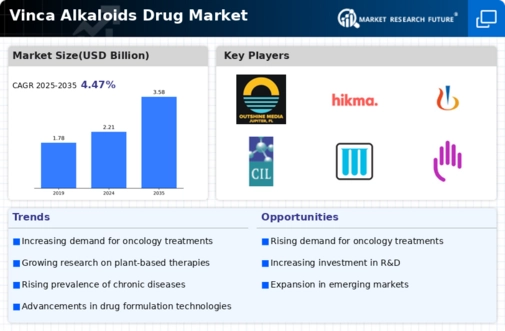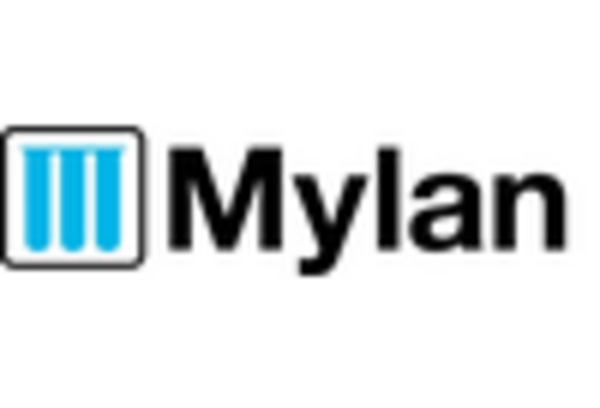Increasing Cancer Incidence
The rising incidence of cancer worldwide is a primary driver for the Vinca Alkaloids Drug Market. As cancer remains a leading cause of mortality, the demand for effective treatment options continues to escalate. Vinca alkaloids, known for their efficacy in treating various cancers, including leukemia and lymphoma, are increasingly being utilized in clinical settings. According to recent statistics, cancer cases are projected to rise significantly, which may lead to a corresponding increase in the consumption of Vinca alkaloids. This trend suggests that pharmaceutical companies are likely to invest more in research and development of these drugs, thereby expanding their market presence. The Vinca Alkaloids Drug Market is thus positioned to experience growth as healthcare providers seek effective therapies to combat the growing cancer burden.
Innovations in Pharmaceutical Research
Innovations in pharmaceutical research are propelling the Vinca Alkaloids Drug Market forward. Advances in drug formulation and synthesis techniques have enhanced the efficacy and safety profiles of Vinca alkaloids. Researchers are exploring novel combinations and delivery methods that could improve patient outcomes. For instance, the development of liposomal formulations of Vinca alkaloids has shown promise in reducing side effects while maintaining therapeutic effectiveness. Furthermore, the integration of biotechnology in drug development is likely to yield new derivatives of Vinca alkaloids, potentially expanding their therapeutic applications. This ongoing research and innovation may attract investment and drive market growth, as stakeholders recognize the potential of Vinca alkaloids in treating various malignancies.
Expansion of Oncology Treatment Centers
The expansion of oncology treatment centers is a significant driver for the Vinca Alkaloids Drug Market. As more specialized facilities emerge to cater to the increasing number of cancer patients, the demand for effective chemotherapeutic agents, including Vinca alkaloids, is expected to grow. These centers often focus on providing comprehensive cancer care, which includes the administration of Vinca alkaloids as part of their treatment protocols. Additionally, the establishment of new treatment centers in underserved regions may enhance access to these vital drugs, further driving market growth. The Vinca Alkaloids Drug Market is likely to see increased sales as healthcare systems invest in expanding their oncology services to meet the rising demand for cancer treatment.
Regulatory Support for Cancer Therapies
Regulatory support for cancer therapies is fostering growth in the Vinca Alkaloids Drug Market. Regulatory agencies are increasingly prioritizing the approval of innovative cancer treatments, including those based on Vinca alkaloids. This supportive environment encourages pharmaceutical companies to invest in the development and commercialization of these drugs. Recent initiatives aimed at expediting the approval process for oncology drugs may lead to a surge in new Vinca alkaloid formulations entering the market. Furthermore, favorable reimbursement policies for cancer treatments can enhance patient access to these therapies, thereby increasing their utilization. The Vinca Alkaloids Drug Market is poised to benefit from this regulatory landscape, as it facilitates the introduction of new and effective treatment options for cancer patients.
Growing Awareness of Personalized Medicine
The growing awareness and adoption of personalized medicine are influencing the Vinca Alkaloids Drug Market. As healthcare shifts towards tailored treatment approaches, the role of Vinca alkaloids in personalized cancer therapy is becoming more pronounced. Oncologists are increasingly considering genetic profiling to determine the most effective treatment regimens for individual patients, which may include Vinca alkaloids. This trend is supported by clinical studies indicating that certain patient populations respond better to these drugs. Consequently, the demand for Vinca alkaloids is likely to rise as healthcare providers seek to optimize treatment outcomes through personalized strategies. The Vinca Alkaloids Drug Market stands to benefit from this paradigm shift, as it aligns with the broader movement towards individualized healthcare.


















Leave a Comment